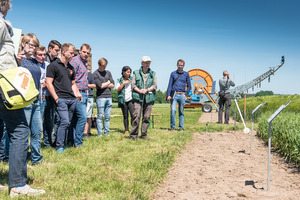Implementation of catch crops for drinking water protection (Germany)
The municipality of Lemförde, Lower Saxony, is responsible for the regional supply of drinking water. This water is sourced from an area of agricultural use. While most suppliers of drinking water in Lower Saxony are organized in greater associations, the direct responsibility of the municipality is a rare and special situation. To provide good quality drinking water, all water protection areas under agricultural use are regulated by special guidance. Farmers are also offered adjustment payments if they subscribe to different special measures. These actions are financed partly by the water supplier and partly by a water treatment fee. Since there are several farms with different farm types, many different needs have to be taken into account to ensure an efficient and voluntarily cooperation between the municipality and the local farmers.

Problem encountered
Since threshold values for nitrate have to be met in the provided drinking water, measures had to be implemented to guarantee the best quality possible. Farms in this region mostly grew winter cereals and kept livestock. Therefore, regulated nitrogen fertilization and the reduction of residual nitrogen after the harvest of the cereals were the main goals. Changes to crop rotations with a greater percentage of maize for biogas production, coupled with a higher availability of organic fertilizers, increased the need for these solutions over the years.
Solutions implemented
Besides stricter rules for nitrogen fertilization and the use of organic fertilizers, the reduction of residual soil nitrogen after harvest needed to be addressed by the integration of additional winter catch crops in modified crop rotations with maize. In addition, incentives for reduced tillage measures in autumn were needed. After several years of subsidised measures, the system was changed to a general results-oriented payment, giving the farmers more freedom in their implementation of these measures.
Challenges encountered
With the promotion of biogas production from plant biomass, maize became more widely grown in the area and non-local farmers were able to rent fields there. This not only changed crop rotation and increased organic fertilizer availability, but farmers lacking good contacts with the local farmers and to the administration started working inside the water protection area. Another important side effect of the biogas promotion was an increase in rental-prices for land, leading to the need for higher farming intensity on the fields. This left fewer opportunities for water protection measures, even for the local farmers. At the same time, the adjustment payments can hardly compete with the economic benefits of simpler and less favourable crop rotations.
Why was it successful in this case?
While the granted adjustment payments played an important role in the successful sustainable implementation of catch crops over winter and reduced tillage in autumn, the special combination of participants in this area played a key role in its success. Since all the people in charge of the administration were based in the region, a good level of contact between administration and farmers could be maintained. This helped to solve problems and facilitated the discussion of issues in a personal way. With most participants also being in contact in their private life, everyone could identify with the targets and needs of water protection and their role in this cooperation. Good contact between local farmers, the administration and the advisors in charge also helped to translate the regulative needs into practical solutions, implemented by many farmers in the area.
 tap and then scroll down to the Add to Home Screen command.
tap and then scroll down to the Add to Home Screen command.